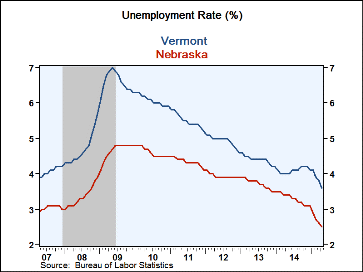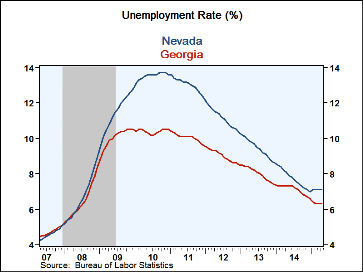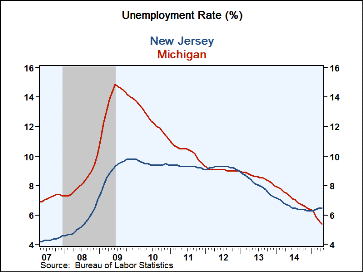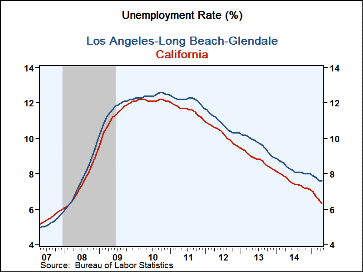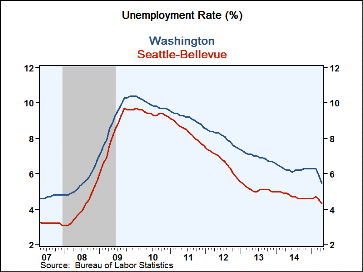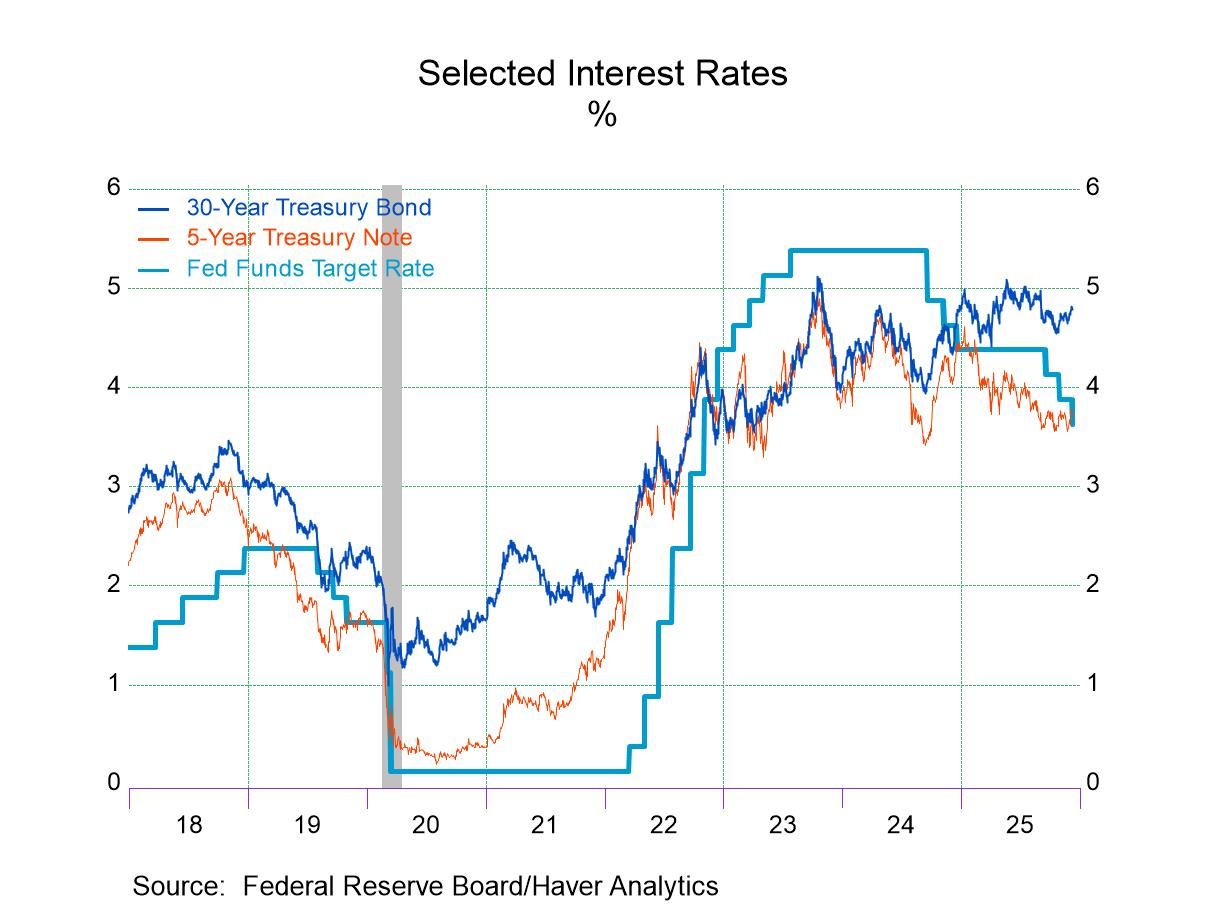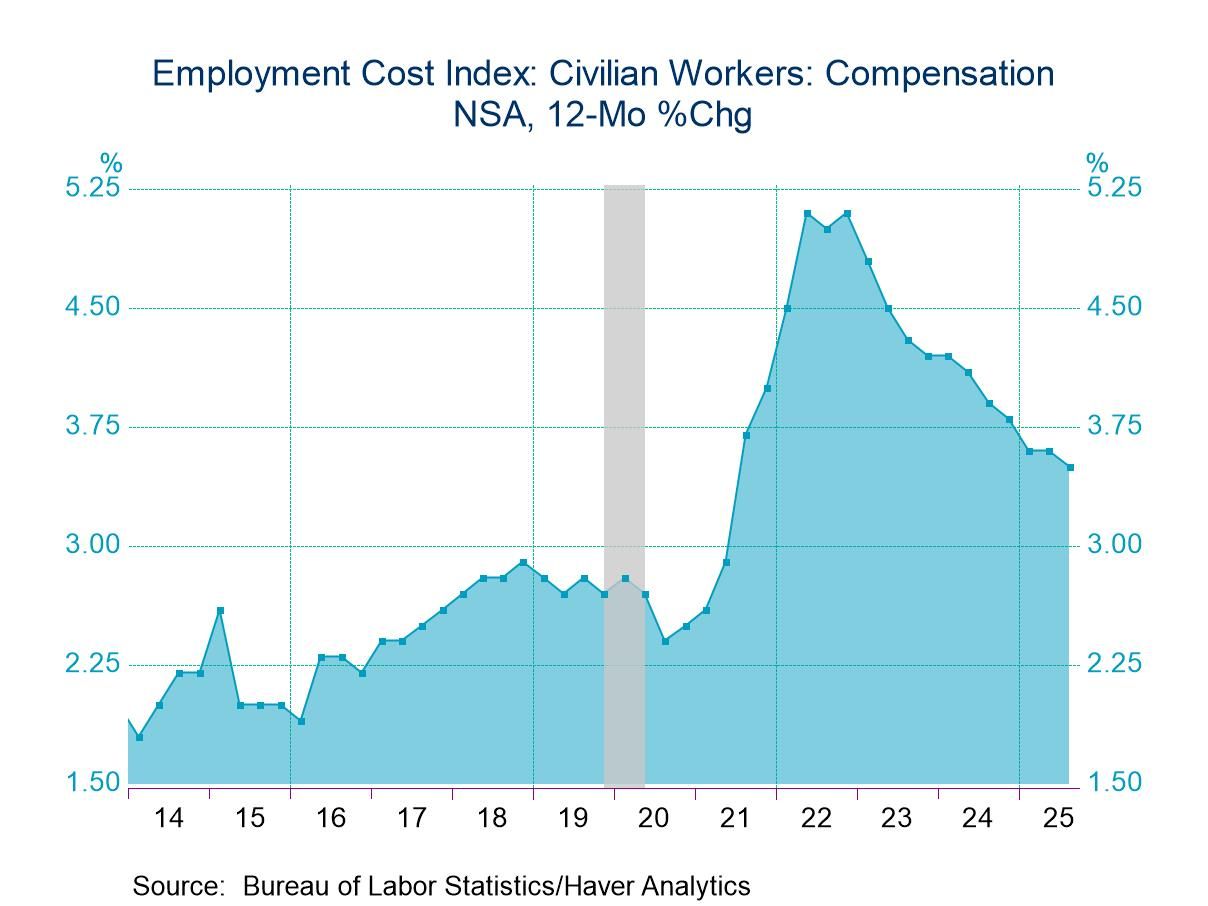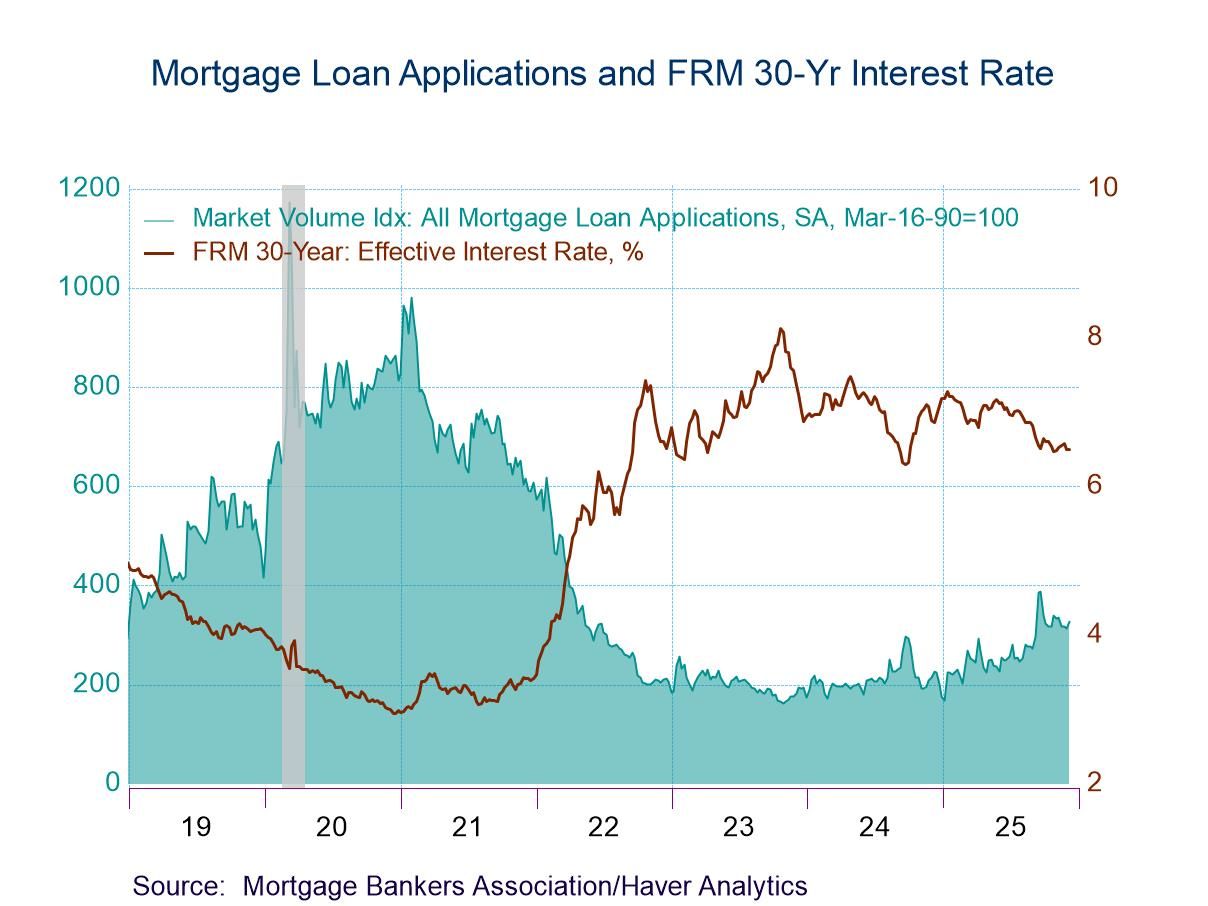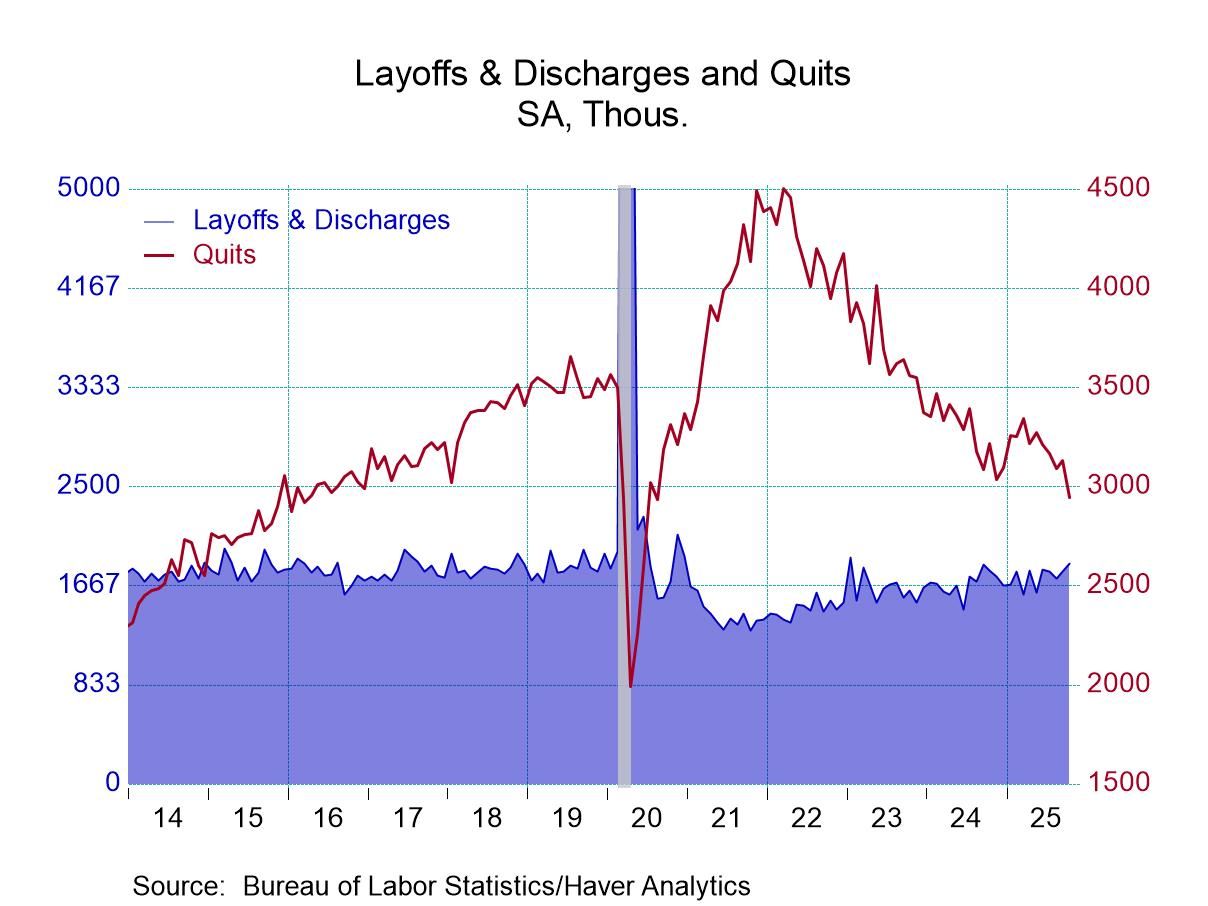 Global| May 27 2015
Global| May 27 2015U.S. State Unemployment Rates Trend Lower but Vary Widely
by:Tom Moeller
|in:Economy in Brief
Summary
The overall U.S. unemployment rate in April of 5.4% stood at its lowest point since August 2008, remaining down from the late-2009 peak of 10.0%. The same declining trend is certainly evident amongst the states, but great variation [...]
The overall U.S. unemployment rate in April of 5.4% stood at its lowest point since August 2008, remaining down from the late-2009 peak of 10.0%. The same declining trend is certainly evident amongst the states, but great variation continues to exist from one state to another. The lowest rates of joblessness are evident in less populated states such as Nebraska (2.5%), North Dakota (3.1%), Utah (3.4%), Vermont (3.6%), Wyoming (4.1%) and Delaware (4.5%). A few of the more populated states, however, are at the low end of the scale. These include Minnesota (3.7%), Texas (4.2%), Wisconsin (4.4%) and Virginia (4.8%).
In general, unemployment runs higher in states with bigger populations. These include South Carolina (6.7%), New Jersey (6.5%), California (6.3%), Georgia (6.3%), Illinois (6.0%), Tennessee (6.0%) and New York. Higher rates of unemployment are not, however, only to be found in large states. Several of the smallest states are experiencing high levels of unemployment, including Nevada (7.1%), West Virginia (where it recently jumped to 7.0%), New Mexico (6.2%), as well as Puerto Rico (12.2%) and the District of Columbia (7.5%).
The unemployment rate figures in individual metropolitan areas, for the most part, continued to differ widely from the state numbers. Florida's 5.6% unemployment rate was below the 6.2% rate in the Miami metro area. Both were, however, roughly half the 2010 figure. Michigan's 5.4% unemployment rate also was under the 6.2% figure around Detroit, and both rates recently fell sharply. In 2009, Detroit's rate reached 16.0%. New York state's 5.7% unemployment rate was below the sharply reduced 6.5% in New York City while California's 6.3% rate was under the 7.6% rate around Los Angeles. Also, Ohio's 5.2% rate was below Cleveland's of 5.8%. Working the other way, Washington state's 5.5% jobless rate exceeded Seattle's 4.3%.
State unemployment figures are available in Haver's EMPLR database.
| Apr | Mar | 2014 | 2013 | 2012 | 2011 | Labor Force | |
|---|---|---|---|---|---|---|---|
|
Total U.S. Unemployment Rate |
5.4% | 5.5% | 6.1% | 7.4% | 8.1% | 8.9% | 155.9 million |
| Ten States With Lowest Jobless Rate | |||||||
| Virginia | 4.8 | 4.8 | 5.2 | 5.7 | 6.0 | 6.6 | 4.3 million |
| Delaware | 4.5 | 4.6 | 5.7 | 6.7 | 7.2 | 7.5 | 0.5 |
| Wyoming | 4.1 | 4.1 | 4.3 | 4.7 | 5.3 | 5.8 | 0.3 |
| New Hampshire | 3.8 | 3.9 | 4.3 | 5.1 | 5.5 | 5.4 | 0.7 |
| Iowa | 3.8 | 4.0 | 4.4 | 4.8 | 5.1 | 5.6 | 1.7 |
| Minnesota | 3.7 | 3.8 | 4.1 | 5.0 | 5.6 | 6.5 | 3.0 |
| Vermont | 3.6 | 3.8 | 4.1 | 4.4 | 5.0 | 5.5 | 0.3 |
| Utah | 3.4 | 3.4 | 3.8 | 4.7 | 5.4 | 6.7 | 1.4 |
| North Dakota | 3.1 | 3.1 | 2.8 | 2.9 | 3.1 | 3.5 | 0.4 |
| Nebraska | 2.5 | 2.6 | 3.3 | 3.8 | 4.0 | 4.4 | 1.0 |
|
Ten States With Highest Jobless Rate |
|||||||
| Nevada | 7.1 | 7.1 | 7.8 | 9.6 | 11.2 | 13.1 | 1.4 |
| South Carolina | 6.7 | 6.7 | 6.4 | 7.6 | 9.2 | 10.6 | 2.2 |
| New Jersey | 6.5 | 6.5 | 6.7 | 8.1 | 9.3 | 9.3 | 4.5 |
| California | 6.3 | 6.5 | 7.5 | 8.9 | 10.4 | 11.7 | 18.8 |
| Georgia | 6.3 | 6.3 | 7.2 | 8.2 | 9.2 | 10.2 | 4.8 |
| Tennessee | 6.0 | 6.3 | 6.7 | 7.8 | 7.8 | 9.0 | 3.0 |
| Illinois | 6.0 | 6.0 | 7.1 | 9.1 | 9.0 | 9.7 | 6.5 |
| New York | 5.7 | 5.7 | 6.3 | 7.7 | 8.5 | 8.3 | 9.6 |
| North Carolina | 5.5 | 5.4 | 6.1 | 7.9 | 9.2 | 10.2 | 4.7 |
| Michigan | 5.4 | 5.6 | 7.3 | 8.9 | 9.1 | 10.4 | 4.8 |
| Jobless Rate In Other Selected Large States | |||||||
| Louisiana | 6.6 | 6.6 | 6.4 | 6.7 | 7.1 | 7.8 | 2.2 million |
| Arizona | 6.0 | 6.2 | 6.9 | 7.8 | 8.4 | 9.5 | 3.1 |
| New York | 5.7 | 5.7 | 6.3 | 7.7 | 8.5 | 8.3 | 9.6 |
| Florida | 5.6 | 5.7 | 6.3 | 7.3 | 8.5 | 10.0 | 9.6 |
| Washington | 5.5 | 5.9 | 6.2 | 7.0 | 8.1 | 9.2 | 3.05 |
| Indiana | 5.4 | 5.8 | 6.0 | 7.7 | 8.3 | 9.1 | 3.2 |
| Ohio | 5.2 | 5.1 | 5.7 | 7.5 | 7.4 | 8.8 | 5.7 |
| Massachusetts | 4.7 | 4.8 | 5.8 | 6.7 | 6.7 | 7.3 | 3.6 |
| Wisconsin | 4.4 | 4.6 | 5.5 | 6.8 | 7.0 | 7.8 | 3.1 |
| Texas | 4.2 | 4.2 | 5.1 | 6.2 | 6.7 | 7.7 | 13.1 |
Tom Moeller
AuthorMore in Author Profile »Prior to joining Haver Analytics in 2000, Mr. Moeller worked as the Economist at Chancellor Capital Management from 1985 to 1999. There, he developed comprehensive economic forecasts and interpreted economic data for equity and fixed income portfolio managers. Also at Chancellor, Mr. Moeller worked as an equity analyst and was responsible for researching and rating companies in the economically sensitive automobile and housing industries for investment in Chancellor’s equity portfolio. Prior to joining Chancellor, Mr. Moeller was an Economist at Citibank from 1979 to 1984. He also analyzed pricing behavior in the metals industry for the Council on Wage and Price Stability in Washington, D.C. In 1999, Mr. Moeller received the award for most accurate forecast from the Forecasters' Club of New York. From 1990 to 1992 he was President of the New York Association for Business Economists. Mr. Moeller earned an M.B.A. in Finance from Fordham University, where he graduated in 1987. He holds a Bachelor of Arts in Economics from George Washington University.



